Small populations can behave differently from larger populations. They are often the result of population bottlenecks from larger populations, leading to loss of heterozygosity and reduced genetic diversity and loss or fixation of alleles and shifts in allele frequencies. A small population is then more susceptible to demographic and genetic stochastic events, which can impact the long-term survival of the population. Therefore, small populations are often considered at risk of endangerment or extinction, and are often of conservation concern.

Habitat conservation is a management practice that seeks to conserve, protect and restore habitats and prevent species extinction, fragmentation or reduction in range. It is a priority of many groups that cannot be easily characterized in terms of any one ideology.

Ecosystem diversity deals with the variations in ecosystems within a geographical location and its overall impact on human existence and the environment.

Tropical rainforests are rainforests that occur in areas of tropical rainforest climate in which there is no dry season – all months have an average precipitation of at least 60 mm – and may also be referred to as lowland equatorial evergreen rainforest. True rainforests are typically found between 10 degrees north and south of the equator ; they are a sub-set of the tropical forest biome that occurs roughly within the 28-degree latitudes. Within the World Wildlife Fund's biome classification, tropical rainforests are a type of tropical moist broadleaf forest that also includes the more extensive seasonal tropical forests.
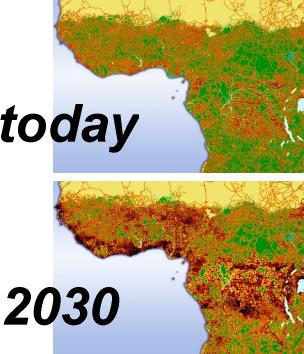
Habitat fragmentation describes the emergence of discontinuities (fragmentation) in an organism's preferred environment (habitat), causing population fragmentation and ecosystem decay. Causes of habitat fragmentation include geological processes that slowly alter the layout of the physical environment, and human activity such as land conversion, which can alter the environment much faster and causes the extinction of many species. More specifically, habitat fragmentation is a process by which large and contiguous habitats get divided into smaller, isolated patches of habitats.
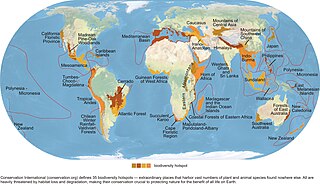
Habitat destruction is the process by which a natural habitat becomes incapable of supporting its native species. The organisms that previously inhabited the site are displaced or dead, thereby reducing biodiversity and species abundance. Habitat destruction is the leading cause of biodiversity loss. Fragmentation and loss of habitat have become one of the most important topics of research in ecology as they are major threats to the survival of endangered species.

Wildlife conservation refers to the practice of protecting wild species and their habitats in order to maintain healthy wildlife species or populations and to restore, protect or enhance natural ecosystems. Major threats to wildlife include habitat destruction, degradation, fragmentation, overexploitation, poaching, pollution, climate change, and the illegal wildlife trade. The IUCN estimates that 42,100 species of the ones assessed are at risk for extinction. Expanding to all existing species, a 2019 UN report on biodiversity put this estimate even higher at a million species. It is also being acknowledged that an increasing number of ecosystems on Earth containing endangered species are disappearing. To address these issues, there have been both national and international governmental efforts to preserve Earth's wildlife. Prominent conservation agreements include the 1973 Convention on International Trade in Endangered Species of Wild Fauna and Flora (CITES) and the 1992 Convention on Biological Diversity (CBD). There are also numerous nongovernmental organizations (NGO's) dedicated to conservation such as the Nature Conservancy, World Wildlife Fund, the Wild Animal Health Fund and Conservation International.
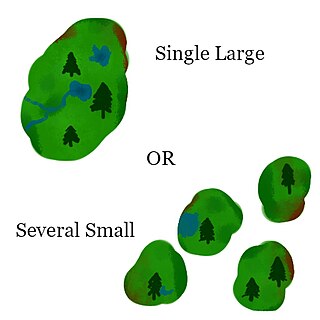
The SLOSS debate was a debate in ecology and conservation biology during the 1970's and 1980's as to whether a single large or several small (SLOSS) reserves were a superior means of conserving biodiversity in a fragmented habitat. Since its inception, multiple alternate theories have been proposed. There have been applications of the concept outside of the original context of habitat conservation.
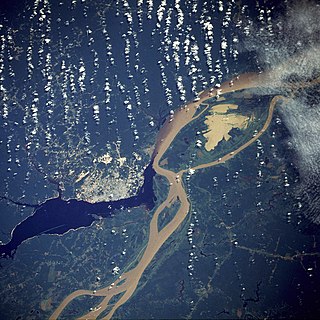
The Biological Dynamics of Forest Fragments Project is a large-scale ecological experiment looking at the effects of habitat fragmentation on tropical rainforest. The experiment which was established in 1979 is located near Manaus in the Brazilian Amazon rainforest. The project is jointly managed by the Amazon Biodiversity Center and the Brazilian Institute for Research in the Amazon (INPA).

The black bearded saki is a species of New World monkey, native to the Amazon rainforest of South America, specifically to an area of north-eastern Brazil. It is one of five species of bearded saki. Bearded sakis are medium-sized (50 cm), mostly frugivorous primates, specialised in seed predation. The genus name Chiropotes means "hand-drinker" as they have been observed using their hands as ladles for scooping water into their mouths. This behavior is thought to be a way of maintaining and protecting their characteristic beards. The black bearded sakis habitat has undergone heavy habitat fragmentation, making the future conservation status of the species uncertain.
Extinction vortices are a class of models through which conservation biologists, geneticists and ecologists can understand the dynamics of and categorize extinctions in the context of their causes. This model shows the events that ultimately lead small populations to become increasingly vulnerable as they spiral toward extinction. Developed by M. E. Gilpin and M. E. Soulé in 1986, there are currently four classes of extinction vortices. The first two deal with environmental factors that have an effect on the ecosystem or community level, such as disturbance, pollution, habitat loss etc. Whereas the second two deal with genetic factors such as inbreeding depression and outbreeding depression, genetic drift etc.
Ecological collapse refers to a situation where an ecosystem suffers a drastic, possibly permanent, reduction in carrying capacity for all organisms, often resulting in mass extinction. Usually, an ecological collapse is precipitated by a disastrous event occurring on a short time scale. Ecological collapse can be considered as a consequence of ecosystem collapse on the biotic elements that depended on the original ecosystem.
Patch dynamics is an ecological perspective that the structure, function, and dynamics of ecological systems can be understood through studying their interactive patches. Patch dynamics, as a term, may also refer to the spatiotemporal changes within and among patches that make up a landscape. Patch dynamics is ubiquitous in terrestrial and aquatic systems across organizational levels and spatial scales. From a patch dynamics perspective, populations, communities, ecosystems, and landscapes may all be studied effectively as mosaics of patches that differ in size, shape, composition, history, and boundary characteristics.
Genetic erosion is a process where the limited gene pool of an endangered species diminishes even more when reproductive individuals die off before reproducing with others in their endangered low population. The term is sometimes used in a narrow sense, such as when describing the loss of particular alleles or genes, as well as being used more broadly, as when referring to the loss of a phenotype or whole species.
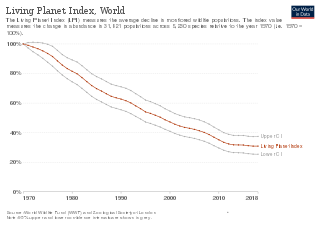
Defaunation is the global, local, or functional extinction of animal populations or species from ecological communities. The growth of the human population, combined with advances in harvesting technologies, has led to more intense and efficient exploitation of the environment. This has resulted in the depletion of large vertebrates from ecological communities, creating what has been termed "empty forest". Defaunation differs from extinction; it includes both the disappearance of species and declines in abundance. Defaunation effects were first implied at the Symposium of Plant-Animal Interactions at the University of Campinas, Brazil in 1988 in the context of Neotropical forests. Since then, the term has gained broader usage in conservation biology as a global phenomenon.
In ecology, extinction debt is the future extinction of species due to events in the past. The phrases dead clade walking and survival without recovery express the same idea.

William F. Laurance, also known as Bill Laurance, is Distinguished Research Professor at James Cook University, Australia and has been elected as a Fellow of the Australian Academy of Science. He has received an Australian Laureate Fellowship from the Australian Research Council. He held the Prince Bernhard Chair for International Nature Conservation at Utrecht University, Netherlands from 2010 to 2014.

Linear infrastructure intrusions into natural ecosystems are man-made linear infrastructure such as roads and highways, electric power lines, railway lines, canals, pipelines, firebreaks, and fences. These intrusions cause linear opening through the habitat or breakage in landscape connectivity due to infrastructure creation and maintenance, which is known to have multiple ecological effects in terrestrial and aquatic ecosystems. These effects include habitat loss and fragmentation, spread of invasive alien species, desiccation, windthrow, fires, animal injury and mortality, changes in animal behaviour, pollution, microclimate and vegetation changes, loss of ecosystem services, increased pressures from development, tourism, hunting, garbage disposal, and associated human disturbances. These intrusions, considered crucial infrastructure for economic sectors such as transportation, power, and irrigation, may also have negative social impacts on indigenous and rural people through exposure to novel social and market pressures, loss of land and displacement, and iniquitous distribution of costs and benefits from infrastructure projects. The study of the ecological effects of linear infrastructure intrusions has spawning sub-fields of research such as road ecology and railroad ecology.

Road expansion refers to the increasing rate at which roads are being constructed globally. Increases in population size and GDP, particularly in developing nations, are the primary drivers of road expansion but transportation planning decisions also play an important role. The anticipated length of newly paved roads to be built between 2010 and 2050 would encircle the planet more than 600 times. Approximately 90% of the new roads are being built in developing nations. Africa and Southeast Asia are predicted to have a large amount of road expansion in the near future.

The barrier effect of roads and highways is a phenomenon usually associated with landscape ecology, referring to the barrier that linear infrastructure like roads or railways place on the movement of animals. Largely viewed as a negative process, the barrier effect has also been found to have several positive effects, particularly with smaller species. To reduce a road or railway's barrier effect, wildlife crossings are regarded as one of the best mitigation options, ideally in combination with wildlife fencing. The barrier effect is closely linked to habitat fragmentation and road ecology.













